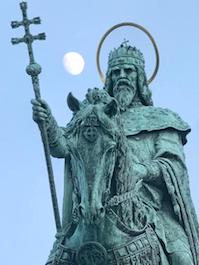Saint Stephen of Hungary
- JOHN JANARO
The story of the conversion of Saint Stephen is inseparable from the story of the thousand-year-old Hungarian nation.

Stephen was the protagonist who forged a warlike and unstable ethnic group into a Christian kingdom in central Europe.
Several new nations emerged during the 10th and 11th centuries in Europe. At the beginning of this period, a variety of tribes and migrants dwelt at the boundaries of the Byzantine Empire and the remnants of Charlemagne's realms (that were undergoing a process of Germanic revitalization).
Among these were the Magyars (called "Hungarians" by the Byzantines), a nomadic confederation originating around the Ural Mountains. In the 9th century, they crossed over the Carpathians, and conquered and settled the plains around the eastern portion of the Danube River. From there they began to raid and pillage the Western and Byzantine Empires. At the same time, as they adopted a more settled lifestyle, they were influenced by the older European societies and gradually welcomed Christian missionaries and converts among themselves.
Missionaries approached primitive, dangerous, violent new peoples by seeking to gain converts among the leading families and, if possible, the chieftains. Both Latin and Byzantine missionaries began to have success among the Hungarians by the middle of the 10th century. But it was the intrepid Saint Adalbert of Prague who finally baptized Geza, the Grand Prince of the confederacy, in the year 985. Baptism was mostly a political arrangement for Geza, but it was clearly something more for his adolescent son who was also baptized on that day.
Young Prince Vajk took the name "Stephen" at his baptism. He also found a mentor in the learned, wise, and energetic Adalbert. Illuminated by faith in Christ and the guidance of this great missionary bishop, Stephen sought to become more than just another Magyar warrior chieftain. He aimed for something that, in retrospect, we might call an achievement of Christian humanism: to transform the barbarous, thieving, raping, murdering pagan Hungarians into a civilized nation at the crossroads of Europe, a nation whose people were suffused with the hope of salvation in eternal life, and who lived in peace and freedom in the present world.
We often forget that the ideal of the Roman Empire was very much alive in the Middle Ages. It was an ideal that developed not only in the direction of a universal earthly emperor, but also in the direction of identity and freedom for a wide variety of peoples under their own local rulers. The ideal aimed at both solidarity and subsidiarity, although these two aspects nearly always conflicted in practical life.
The Hungarians, moreover, were positioned between two empires, the Byzantine and the newly invigorated Holy Roman Empire. When Stephen became Hungary's first king, however, he received the crown directly from Pope Sylvester II, insuring both the political independence and Catholic identity of his people.
Uniting and Christianizing these people, unfortunately, was not accomplished without the use of force and even brutal tactics. However we must understand the many actions and flaws of King Saint Stephen in the context of their time and place, where "imposing Christianity" was often inseparable from establishing the rule of law and basic human civility on a collection of warlords and bandits. The Hungarian people to this day remember his legacy with gratitude and devotion.
 This is Meaghen Gonzalez, Editor of CERC. I hope you appreciated this piece. We curate these articles especially for believers like you.
This is Meaghen Gonzalez, Editor of CERC. I hope you appreciated this piece. We curate these articles especially for believers like you.
Please show your appreciation by making a $3 donation. CERC is entirely reader supported.

Acknowledgement
 John Janaro "Saint Stephen of Hungary." Magnificat (April, 2019).
John Janaro "Saint Stephen of Hungary." Magnificat (April, 2019).
Reprinted with permission of Magnificat.
The Author

 John Janaro is Associate Professor Emeritus of Theology at Christendom College. He is a Catholic theologian, and a writer, researcher, and lecturer on issues in religion and culture. He is the author of Never Give Up: My Life and God's Mercy and The Created Person and the Mystery of God: The Significance of Religion in Human Life. He is married to Eileen Janaro and has five children.
John Janaro is Associate Professor Emeritus of Theology at Christendom College. He is a Catholic theologian, and a writer, researcher, and lecturer on issues in religion and culture. He is the author of Never Give Up: My Life and God's Mercy and The Created Person and the Mystery of God: The Significance of Religion in Human Life. He is married to Eileen Janaro and has five children.




